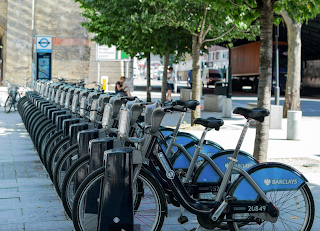By having the pleasure of living in Copenhagen, a city with 300km of bike lanes, I am one of the 52% of ‘Copenhageners’ who commute daily by bicycle. The cycling infrastructure is staggeringly impressive, where cyclists have their own traffic signals, there are angled bins at the side of roads, and people handing out free newspapers to passing cyclists. I was also impressed by the fact that it is socially acceptable for all ages and social backgrounds to cycle every day as it is the cheapest and quickest form of transport.
However it doesn’t stop there. If you have stroll down to the many lakes of Copenhagen, you will always see a number of individuals running around the water. There is also endless amounts of green space, where a substantial amount are filled with sports facilities, such as football pitches, which are free for the public to use. If outdoor exercise is not to your taste, then not to worry, as there is a wealth of affordable gymnasiums and fitness centers to satisfy your every need. Overall some may say that the Danish urban design lends itself to individuals being physically fit in a bustling vibrant city.
This subsequently contributes to Denmark having an impressive physical inactivity of 36.6% and obesity rates of 18.2% compared to the UK’s 66.5% and 26.9% retrospectively. This lead to me to question, does this lifestyle factor result in a variation in diseases which affect Danes and Britons ?
I was intrigued to discover that there was in-fact little difference between blood pressure, blood glucose and the major causes of NCD related mortalities. On the other hand maybe I was expecting too much as we are not too dissimilar culturally when it comes to alcohol consumption. Could alcohol consumption and the higher rate of tobacco consumption cancel out the physical activity advantage that Danes have over Britons ? Regardless both the factors of alcohol and tobacco consumption are two of the biggest contributors factors to developing NCDs. Maybe the Danish diet has a role ?
I was intrigued to discover that there was in-fact little difference between blood pressure, blood glucose and the major causes of NCD related mortalities. On the other hand maybe I was expecting too much as we are not too dissimilar culturally when it comes to alcohol consumption. Could alcohol consumption and the higher rate of tobacco consumption cancel out the physical activity advantage that Danes have over Britons ? Regardless both the factors of alcohol and tobacco consumption are two of the biggest contributors factors to developing NCDs. Maybe the Danish diet has a role ?
Well Danes genuinely have a relatively positive nutritional status with high fibre products, such as smorebrod (rye bread) frequently consumed, high omega 3 intake due to a large amount of fish consumed, and most food products are low in sugar. There was also a tax on carbonated soft drinks and foods which are high in saturated fat. This could be an indication to why Copenhagen has few major fast food outlets compared to the major UK cities. Danes also have traditional eating habits, with more meals centered around families eating together, compared to eating alone and snacking between meals. There are also a greater variety of organic options and the price between organic and non organic options is minimal. The minor blip in the Danish diet is that there is a high red meat consumption, with particular focus on pork, which results in high intake of saturated fat. British dietary intake is equally high in saturated fat, but also centered around food items which are more energy dense, have lower fibre content and a general lack of fruit and vegetables. Generally speaking though, the Danish diet is nutritionally positive and this ultimately has a positive physiological impact on the body.
 |
The Danish taking red meat to a different level in the Copenhagen Food Festival
|
However once you have got a nutritional diet, low alcohol and tobacco consumption, along with all the positive governmental, political, environmental and cultural factors in place, how do you create an urban environment which is centered around physical activity ? London is one of the biggest urban cities in the world and in 2010, the Greater London Authority launched a bicycle sharing system. The ‘Boris Bikes’, as they are commonly referred to after the major of London, Boris Johnson, increased the number of commuters on bike to 24% in 2013. However surveys have suggested that the reason why more commuter’s don’t travel by bicycle is a lack of safety on the road due to absence of any road infrastructure to include mass designated cycle areas. This is also a common problem for commuters in other areas of Britain. Scotland aims to have 10% of all journeys in 2020 to involve cycling, which is a stark contrast to the 0.69% which it currently stands at. Bikes are also considerably cheaper in Scotland, compared to Copenhagen, and nearly 70% of all school pupils are provided with public cycling training. Unfortunately though a lack of cycle lanes, road safety, poor road layouts and a lack of safe storage results in many choosing alternative means of transport which involve less physical activity.
 |
London’s ‘Boris Bikes’
|
No comments:
Post a Comment